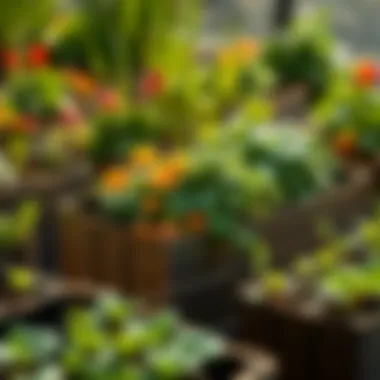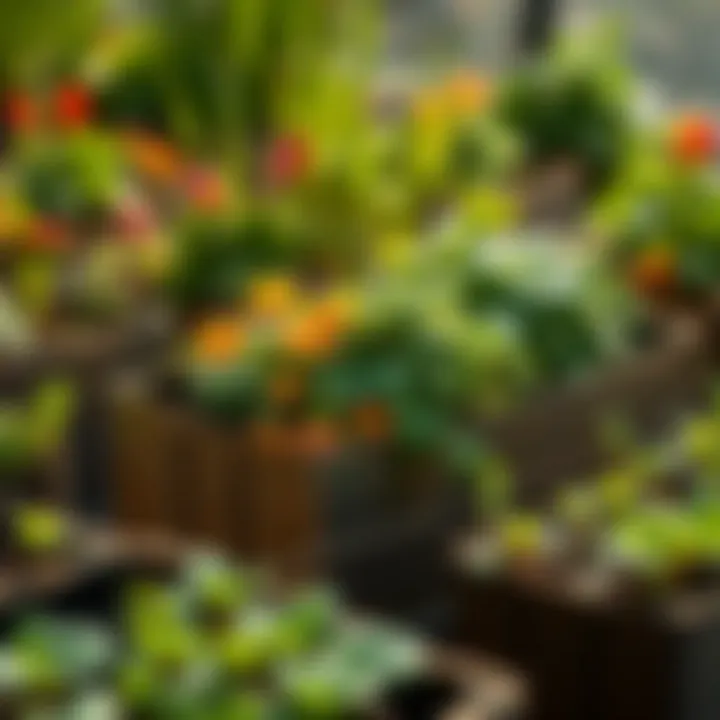Essential Insights on Complete Grow Box Kits


Intro
In today's rapidly evolving agricultural landscape, complete grow box kits have emerged as a beneficial tool for farmers and gardening enthusiasts alike. These kits combine essential components for gardening into a comprehensive setup, allowing users to cultivate plants with ease, whether they are seasoned horticulturists or beginners just dipping their toes into the world of gardening.
The drive towards self-sustainable and eco-friendly practices in agriculture can't be overemphasized. As pressures mount from food production demands and climate change, tools such as grow box kits contribute to modern solutions, making agriculture more accessible and efficient. This guide dives into the various aspects of these kits, exploring their components, advantages, and role in sustainable gardening, while offering insights into selecting the right kit for personal needs and aspirations.
Latest Trends in Agriculture
Overview of Current Trends
The agricultural sector is constantly evolving, particularly with the growing interest in urban farming and indoor gardening. Complete grow box kits are part of this trend, appealing to city dwellers who may have limited space for traditional gardening.
Several key trends are shaping modern agriculture:
- Vertical Farming: This technique maximizes space by stacking plants, making it ideal for urban areas.
- Hydroponics: Growing plants in a nutrient-rich solution without soil is gaining popularity, and many grow box kits cater to this method.
- Automation and Smart Technology: Integration of sensors and smart control systems allows for better monitoring of plant health and resource management.
These trends aren’t just about efficiency; they represent a shift towards more sustainable practices, enabling individuals to produce food locally.
Impact of Technology on Farming Practices
With technology playing a pivotal role in agriculture, grow box kits exemplify how traditional methods are being enhanced. This integration brings a slew of benefits:
- Precision Agriculture: Using data and analytics to improve crop yields.
- Remote Monitoring: By utilizing mobile apps, gardeners can oversee their plants' conditions from anywhere.
- Resource Management: Technology reduces waste and optimizes water and nutrient use.
“Where there’s technology, there’s potential for growth—both literally and figuratively in the field of agriculture.”
Sustainable Practices: Towards a Greener Future
Importance of Sustainability in Agriculture
The significance of sustainable practices cannot be overstated. With the impacts of climate change becoming more pronounced, growers are increasingly seeking methods that conserve resources. Complete grow box kits foster sustainability by encouraging local food production and reducing transportation emissions associated with commercially grown food.
Methods for Sustainable Farming
To align with sustainable principles, gardeners can adopt various strategies:
- Companion Planting: This method involves growing plants together that can benefit each other, enhancing biodiversity.
- Organic Fertilizers: Utilizing compost or natural fertilizers enriches the soil without introducing harmful chemicals.
- Rainwater Harvesting: Capturing rainwater for irrigation purposes conserves water and is a resource-efficient practice.
Engaging with sustainable methodologies not only supports the environment but also promotes healthier eating habits.
Gardening Techniques and Tips
Essential Gardening Tools and Equipment
Utilizing the right tools is crucial for achieving a productive garden. Here are some essentials:
- Trowel: Ideal for digging and replanting.
- Pruners: Necessary for trimming and maintaining plants.
- Watering Can: For gentle watering of delicate plants.
- Grow Light: Especially important for indoor gardening when sunlight is limited.
These tools form the backbone of a gardener's kit, enabling effective management.
Seasonal Gardening Practices
Understanding seasonal gardening practices can significantly enhance productivity. Each season has specific actions to consider:
- Spring: Ideal for planting seeds as temperatures rise.
- Summer: Focus on watering and protection from pests.
- Fall: Time for harvesting and preparing the soil for the next planting cycle.
- Winter: Ideal for planning and maintaining equipment.
Incorporating these practices aligned with the seasons leads to healthier plants and improved yields, reminding gardeners that nature operates on its own clock.
Foreword to Grow Box Kits
In today's fast-paced world, gardening often gets left behind, viewed as an inconvenient or impractical endeavor. Enter grow box kits, a solution that packs convenience and efficiency into a single box, literally. These kits have found their way into homes and educational institutions, catering to seasoned professionals and novices alike. Not only do they simplify the growing process, but they also open avenues for sustainable practices.
Like a well-assembled puzzle, every component in a grow box kit fits together perfectly, forming a mini-ecosystem that takes up minimal space while providing optimal conditions for plant growth. From grow lights to ventilation, understanding these components is crucial, as it shapes how we cultivate plants indoors.
Definition and Purpose
At its core, a grow box kit is precisely what it sounds like—a comprehensive set of tools designed to help individuals cultivate plants in a controlled environment. These kits are equipped with everything one needs: lighting systems, growing medium, feeding regimes, and even sometimes, smart sensors. The primary purpose? To create a perfect little habitat for plants to thrive regardless of external weather conditions.
Gardeners can achieve remarkable results without having to rely on unpredictable mother nature. Whether someone is a budding herb-grower, a flower enthusiast, or looking for a more extensive agricultural venture, a grow box kit offers a versatile solution.
Historical Context
The concept of growing plants indoors is not as modern as one might think. Historically, civilizations such as the Ancient Egyptians cultivated plants using rudimentary versions of greenhouse-style structures. However, more recent innovations in gardening technology have truly evolved the idea.
In the late 20th century, advances in hydroponic systems ran alongside growing interest in sustainable practices, giving birth to today’s organized grow systems. The transition from basic methods to engineered grow box kits came as indoor gardening gained momentum; commercially available kits emerged, making it easier for everyday folks to dive in. The demand has only risen as urbanization increases, and people look to maximize limited spaces for food production.
While grow box kits have come a long way, they remain true to their roots—providing an opportunity for everyone to connect with nature, regardless of how busy life may get.
Key Components of a Complete Grow Box Kit
Understanding the key components of a complete grow box kit is crucial for anyone looking to embark on their gardening journey or to enhance their current practices. Each element plays an essential role in ensuring plants grow at an optimal level, whether you're an avid gardener or just beginning to explore this rewarding activity.
Grow Lights
Grow lights serve as the backbone of any indoor garden. They replicate sunlight, allowing plants to undergo photosynthesis and thrive even in spaces with little natural light. There are several types of grow lights, such as LED, fluorescent, and high-intensity discharge (HID) lights. Each comes with its own advantages.
- LED lights are energy efficient and have a long lifespan, making them a popular choice. They produce less heat, reducing energy costs and the need for cooling systems.
- Fluorescent lights are great for seedlings and young plants, as they provide a soft light that doesn't scorch tender foliage.
- HID lights offer intense brightness, beneficial for larger plants or high-yield crops, though they require more careful management of heat output.
Growing Medium
The growing medium anchors the plant and houses essential nutrients, water, and air, making it a critical element in a grow box kit. Various media exist, including soil, coco coir, peat moss, and rock wool, each providing different benefits.
- Soil is traditional and readily available, providing numerous nutrients naturally but can vary greatly in quality.
- Coco coir is a popular alternative that retains moisture and promotes excellent aeration, making it ideal for hydroponic systems.
- Rock wool is another option favored in commercial settings due to its balance of water retention and drainage.
Understanding the specifics of your chosen growing medium allows for better watering techniques and ensures plants receive required nutrients.
Hydration Systems
Keeping plants hydrated is an oft-overlooked component that can lead to severe issues such as overwatering or drought stress. Numerous hydration systems are available that can automate the watering process, including drip irrigation, wicking systems, and hydroponic solutions.
- Drip irrigation systems deliver water directly to the roots, providing consistent moisture while minimizing evaporation losses.
- Wicking systems use a simple method of capillary action to draw water from a reservoir to the soil, perfect for less demanding plants.
- Hydroponic systems eliminate the need for soil entirely, using nutrient-rich water to feed plants, which can enhance growth rates significantly.
The choice of a hydration system often depends on the size of the grow box, the plant types, and personal preferences for maintenance and automation.
Ventilation and Temperature Control
Proper ventilation and temperature control are vital for preventing various plant ailments. Too much heat or humidity can lead to a breeding ground for pests and diseases. Good grow box setups incorporate exhaust fans, intake vents, and thermometers to monitor conditions.
- Exhaust fans help to expel stale, warm air while bringing in cooler air, maintaining a balanced environment.
- Intake vents ensure that fresh air circulates in, assisting plants in respiration.
- Thermometers and hygrometers are essential for monitoring temperature and humidity levels, allowing for prompt adjustments.
By maintaining a conducive environment, you enhance your plants' health and ensure they reach their full potential.
Nutritional Components
Finally, nutrient availability is paramount for plant health. Without the right balance of macro and micronutrients, plants can exhibit stunted growth or deficiencies. Nutritional components typically come in fertilizers, either organic or synthetic.
- Organic fertilizers, like compost or manure, release nutrients slowly and improve soil structure, benefiting long-term growth.
- Synthetic fertilizers provide concentrated nutrients, ideal for rapidly boosting growth but can lead to imbalances if not used carefully.


Selecting the proper nutritional components and understanding the specific needs of your plants can significantly impact your gardening success.
In summation, the key components of a complete grow box kit form an ecosystem that supports healthy plant growth, making it necessary to choose wisely and understand each element.
Benefits of Using Grow Box Kits
Using grow box kits offers a range of significant advantages for urban gardeners, hobbyists, and professional growers alike. As these kits are designed to cater to diverse gardening needs and preferences, understanding their benefits can aid individuals in making informed decisions that align with their growing aspirations. Here’s a closer look at some of the standout benefits of utilizing grow box kits.
Space Efficiency
One of the most notable advantages of grow box kits is their remarkable space efficiency. For urban dwellers or those with limited outdoor areas, these kits provide a viable solution for growing plants conveniently within small confines. The compact design allows for optimal usage of limited spaces, enabling individuals to cultivate a variety of crops even in tight quarters.
- Consider this: a one-square-foot grow box could potentially yield a dozen fresh strawberries, transforming previously unused spaces into productive gardens.
- Moreover, many grow boxes can be stacked or arranged vertically, which maximizes the growth area while minimizing the footprint.
This efficient use of space not only supports urban gardening but also appeals to those passionate about sustainability. Reducing the need for sprawling gardens leaves more room for urban flower beds, parks, or green roofs, contributing to greener cities.
Controlled Environment Features
Grow box kits come equipped with features that control environmental factors, crucial for effective plant cultivation. Inside these kits, the grower can manage light, temperature, humidity, and ventilation more easily than in conventional gardening settings.
Key elements of controlled environments include:
- Grow Lights: Supplying the right spectrum of light mimics nature, encouraging healthy plant growth.
- Temperature Regulation: Heat mats or fans can maintain a consistent temperature that enhances germination and growth rates.
- Humidification Systems: Keeping humidity levels in check is crucial, particularly for delicate seedlings or tropical plants.
With such control, growers can recreate ideal conditions for specific plant types throughout the year, regardless of outside weather fluctuations. This leads to higher success rates and healthier harvests. It’s like having a little piece of the tropics, no matter the frost outside.
Accessibility for Beginners
For individuals newly interested in gardening, grow box kits are incredibly approachable. These kits often come as complete systems with detailed instructions, making them child’s play for beginners. By reducing the complexity typically associated with starting a garden, novices can dive right into the joy of planting and nurturing.
Essential aspects that make grow boxes beginner-friendly include:
- User-Friendly Set-Up: Most kits require minimal assembly, making it easier for the uninitiated.
- Guidance and Support: Many brands offer robust customer support and guides which help newcomers to understand best practices.
- Pre-Configured Nutrient Packs: With nutrients and media included, there’s no guesswork in terms of what to use and how much.
As a result, beginners can enjoy a rewarding experience without feeling overwhelmed. The satisfaction of watching something green sprout often acts as a powerful motivator to explore further into gardening.
"Grow box kits serve as a bridge for beginners into the vast world of gardening, providing both support and the thrill of connection with nature."
Types of Grow Box Kits
When it comes to growing plants indoors or in limited spaces, understanding the different types of grow box kits is essential. Each type serves unique purposes and fits various growing preferences and environmental conditions. Let's dive into the different types and discover how they can meet a gardener’s needs.
Soil-Based Kits
Soil-based kits are perhaps the most traditional form of growing plants, mimicking the natural environment that plants thrive in. These kits typically include containers filled with high-quality soil, which is enriched with nutrients necessary for plant health.
One of the standout features of soil-based kits is their simplicity. They require relatively little technology and are often more forgiving of beginner mistakes. With good soil, a gardener has the foundation for healthy plants. Soil-based grow boxes can vary widely in size and design:
- Container Gardens: These small, portable options make it easy to grow herbs or vegetables.
- Raised Bed Kits: Perfect for those with larger spaces, raised beds can offer better drainage and soil management.
Also, using soil can be quite cost-effective. Chemicals and additives are often less needed, making it a more sustainable option for beginner and seasoned growers alike.
Hydroponic Kits
Hydroponic kits represent a more modern approach, using nutrient-rich water to support plant growth without soil. These kits can be particularly appealing for those living in urban environments with limited space. They often feature:
- Water Reservoirs: Essential for soaking roots in nutrient solutions.
- Grow Trays and Net Pots: To support the plants while allowing roots to access the nutrient solution.
Hydroponics can be very efficient, using less water than traditional methods. Moreover, plants often grow faster due to the direct availability of nutrients. However, they do require more monitoring and setup steps. If you’re considering jumping into hydroponics, be aware:
- Initial Costs: Hydroponic setups can be more expensive upfront compared to soil-based systems.
- Knowledge Investment: Understanding the right nutrient balance can take time. However, forums such as Reddit have communities that can help.
Aeroponic Systems
Aeroponic systems take hydroponics a step further by suspending plants above the ground and misting their roots with a nutrient solution. This method maximizes oxygen availability to the roots, promoting rapid growth.
These systems are perfect for those who wish to maximize yield in minimal space. Some key elements include:
- Misting Nozzles: Deliver water and nutrients directly to roots.
- Organic Grow Mediums: Sometimes incorporated to provide additional support without using soil.
While the advanced nature of aeroponic systems can come across as daunting, they present certain advantages over more traditional methods:
- Space Efficient: Ideal for urban areas as they can be set up vertically.
- Less Water Usage: Since they recycle water, it's more sustainable.
In summary, selecting the type of grow box kit depends heavily on your growing goals and space limitations. Both hydroponic and aeroponic systems bolster plant growth in ways soil can't, but they come with their challenges. On the other hand, soil-based kits may lack the speed of their soil-less counterparts but offer reliability and simplicity that many gardeners cherish. >"Investing in the right kind of grow box kit sets the foundation for successful cultivation."
For more about the scientific principles behind these systems, visit sources like Britannica.com or Wikipedia for in-depth articles.
Selecting the Right Grow Box Kit
Choosing the right grow box kit is essential for achieving success in your gardening endeavors. The right kit not only helps in optimizing plant growth but also simplifies the cultivation process. With a diverse array of kits on the market, understanding specific elements such as your spatial constraints, crop preferences, and budget becomes paramount.
Assessing Your Space Requirements
Before plunging into the purchase of a grow box kit, it’s crucial to evaluate your available space. The dimensions of where you plan to set up your garden can significantly influence the type of kit you need.
- Available Area: Measure your space carefully. Is it a small corner in your basement, an urban balcony, or a spacious backyard? Each environment presents distinct requirements. For instance, a compact apartment might benefit from a vertical kit, while a backyard can accommodate larger setups.
- Height Considerations: Indoor spaces often come with ceilings that can limit the full potential of grow lights. Thus, examining height limitations will influence your grow light choices and plant selection.
- Placement: Consider sun exposure, temperature stability, and ease of access for maintenance. Positioning your grow box in an area with natural light can enhance growth, but supplementary lighting should also be considered if natural light falls short.
Understanding Crop Preferences
After assessing space, the next step is understanding what type of crops you'd like to grow. It sounds straightforward, but crops have varying requirements in terms of light, temperature, and humidity. Here’s a closer look:
- Seed Choices: Some plants thrive in soil, while others do better in hydro systems. Leafy greens like spinach or lettuce often flourish in hydroponic kits, while tomatoes may require more space and specific nutrients found in soil kits.
- Growth Cycle: Understand the vegetative and flowering stages of the plants you aim to cultivate. Plants have different light and water requirements at various stages, so prep accordingly.
- Companion Planting: If you intend to grow multiple types of plants, consider their compatibility. Some plants can benefit from being near each other while others may compete for resources.
This step is vital as understanding the crops will help optimize the environment and resource allocation for each plant type.
Budget Considerations
Lastly, the financial aspect is a critical factor that can’t be overlooked. Grow box kits come in various price points, often affected by features, brand reputation, and included components. Here are a few budgeting tips:
- Assessing Needs vs. Wants: Distinguish between essential features and additional conveniences. Do you need an automated hydration system, or are you comfortable managing it manually? Prioritize features that will genuinely benefit your gardening goals.
- Total Cost of Ownership: Factor in not just the initial kit cost. Consider ongoing expenses like grow lights, nutrients, and potential upgrades over time. This helps in avoiding unplanned financial pressure.
- Value for Money: Cheaper kits might save you cash upfront, but could compromise on quality or longevity. Analyze warranties and customer reviews to get a sense of the product’s durability and support.
Keeping a well-planned budget ensures you do not overextend financially while building a successful growing operation.
In essence, choosing the right grow box kit involves a thoughtful consideration of your spatial constraints, crop preferences, and budgetary limits. Aligning these elements can significantly enhance your gardening experience and outcomes.
Setting Up Your Grow Box Kit
Setting up a grow box kit is no small feat; it’s akin to assembling a jigsaw puzzle where each piece must fit just right to create a harmonious ecosystem for your plants. This section will walk you through the crucial steps and considerations for setting up your grow box effectively. A well-set-up grow box not only maximizes the potential for healthy plant growth but also creates an efficient space for gardening, particularly in urban settings where room can be tight. Understanding how to properly configure various components will lead to higher yields, improved plant health, and a fruitful gardening experience.
Assembling Components
The assembly phase is like building the foundation of a house; without it, nothing can flourish. Start by laying out all the components and reading through the instructions provided. Each grow box kit varies slightly, but the essentials usually include:
- Grow lights
- A growing medium
- Hydration systems
- Ventilation gear
- Nutrient packs
When piecing these together, ensure tight fits and check for the proper orientation of each component. For example, the growing medium should sit securely in the grow trays to prevent spillage and allow for optimal drainage. Remember to use tools like screwdrivers and pliers carefully and avoid overtightening screws which can lead to breaks or cracks in the materials.


Installing Grow Lights
When it comes to light, plants can be pretty picky. Installing grow lights is perhaps one of the most critical steps. Proper light placement affects everything from photosynthesis to overall growth. Follow these guidelines:
- Height Adjustments: Position the grow lights about 12-24 inches above the plants, adjusting as they grow taller.
- Light Cycle: Most plants thrive on a cycle of 16 hours of light and 8 hours of darkness. Timers can simplify this.
- Type of Light: Choose between LED or HID lights based on the energy efficiency and power they provide. LEDs can be more expensive initially, but they last longer and consume less electricity.
The more efficiently you set up the lights, the better your plants will respond to optimum light exposure.
Adjusting Hydration Systems
A curious gardener might ask, "What are the secrets to watering?" The answer lies in properly setting up your hydration systems. Over or under-watering can be detrimental. Here's how you can ensure your plants get just the right amount:
- Check System Type: If using a drip irrigation system, ensure all lines are clear from blockages.
- Water Schedule: A moisture meter can help gauge when plants need water. Generally speaking, it's better to err on the side of underwatering.
- Reservoir Levels: Always monitor the reservoir levels in systems like hydroponics or aquaponics. Keep an eye on nutrient concentration as well to prevent deficiencies.
The goal is to create a consistent moisture level that won’t encourage root rot or drought stress. Think of hydration like Goldilocks: not too much, not too little, but just right.
Configuring Ventilation
Ventilation plays a vital role in preventing mold and ensuring fresh air circulates within the grow box. Without proper air flow, plants can become stressed and disease-prone. To set up your ventilation:
- Exactly Place Fans: Install fans at strategic points to promote good air movement while avoiding direct wind on young plants.
- Utilize Exhaust Systems: An exhaust fan should be installed near the top of the grow box to expel warm air.
- Intake Fans: An intake fan at the bottom will pull in fresh air, maintaining a balanced temperature.
Humidity and temperature are key areas to keep an eye on, and a digital thermometer-hygrometer can be an invaluable tool here. Keeping the environment balanced will help your plants grow strong and vigorously.
"
Remember, every small detail counts. Your setup phase is where successful gardening begins!
By following these steps to set up your grow box kit, you’re not just building a space; you’re creating an inviting environment for vibrant plant growth. Each component is part of a bigger picture, and when they all come together, the results can be rewarding. With careful attention to assembly, lighting, hydration, and ventilation, your grow box is well on its way to becoming a productive oasis.
Maintenance and Care for Grow Box Kits
Maintaining and caring for grow box kits is like tending to a delicate ecosystem. Without regular attention, your oasis of greenery can quickly turn into a wilted disaster. Proper care ensures that plants thrive and produce the desired yield. Regular upkeep not only extends the lifespan of your grow box but also enhances its overall efficiency and productivity. Whether you’re a budding enthusiast or a seasoned farmer, knowing how to look after your kit can make all the difference. Here’s a breakdown of the crucial aspects.
Regular Monitoring
Regular monitoring is the backbone of successful plant care. Like a hawk watching over its nest, constant vigilance allows you to spot potential issues before they become problematic. This includes checking the moisture levels in your growing medium, assessing the temperature, and inspecting your plants.
A quick daily glance can save a lot of time later. Here are some indicators of when to intervene:
- Moisture levels: Excessive moisture can lead to root rot while too little can cause wilting. Use a moisture meter or your fingers to evaluate the soil's dampness.
- Temperature checks: Keeping an eye on temperature ensures that it remains within the ideal range for what you’re growing. Install a thermometer to assist with monitoring.
- Growth patterns: Notice any stunted growth or discoloration in the leaves, which can indicate broader issues.
Utilizing monitoring devices can make this task even easier. Tools like humidity sensors and smart plant monitors can provide real-time data, helping you adjust conditions faster.
Nutrient Management
Nutrient management is akin to feeding your plants a well-balanced diet. Just like humans need an assortment of vitamins and minerals, plants require specific nutrients to flourish.
Key nutrients to focus on include:
- Nitrogen: Essential for leafy growth. Commonly found in fertilizers like urea.
- Phosphorus: Important for root development. Often supplied in the form of bone meal.
- Potassium: Key for overall health; it helps plants withstand disease and fosters quality yield.
You may need to adjust the nutrients based on plant growth stages. Seedlings need a lighter nutrient mix compared to mature plants. Regularly testing the soil or water allows you to ensure nutrient levels are on point. Over- or under-fertilization can be detrimental, so follow instructions carefully. Remember to flush your system periodically to prevent nutrient buildup.
Pest and Disease Control
Pest and disease control can make or break your growing experience. Even the best grow box kits are not immune to the threat of infestations. Pests like aphids or spider mites can suck the life out of your plants. Therefore, proactive measures are vital.
Here’s a list of strategies to keep pests at bay:
- Preventive measures: Ensuring good air circulation and cleanliness in your grow area can deter pests.
- Natural predators: Introduce beneficial insects like ladybugs or predatory mites. These little warriors can help keep the harmful critters in check.
- Regular inspections: Check both the tops and undersides of leaves. If you notice any pests, act fast to remove them, preferably by hand or with a gentle spray of water.
- Organic solutions: In cases of severe infestations, consider using neem oil or insecticidal soap. These can be effective without the harsh chemicals found in many pesticides.
A little prevention goes a long way. Regularly sanitizing tools and handling plants with clean hands can also prevent the spread of diseases.
In summary, maintaining a grow box kit requires diligence and a bit of know-how. Regular monitoring, nutrient management, and pest control are integral to running a successful indoor garden. Adopting these practices will optimize your grow box's potential, ensuring the plants thrive and yield maximum outputs.
Common Challenges with Grow Box Kits
When diving into the world of grow box kits, it’s crucial to recognize that while they provide a structured way to cultivate plants, they are not without their challenges. Understanding these potential pitfalls not only helps mitigate frustrations but also empowers growers to optimize their gardening experience. The significance of identifying common challenges lies in promoting effective solutions and encouraging a more fruitful growing journey.
Overwatering Issues
One of the most frequent headaches for both novice and seasoned growers is overwatering. It’s a delicate dance, as plants need water, yet too much can lead to dire consequences. In a grow box, where the environment is contained, it becomes easier to mistakenly flood the roots, particularly if the hydration system is set incorrectly or the grower is overly enthusiastic with the watering can.
The roots, when soaked too long, begin to suffocate and rot. A telltale sign is yellowing leaves which resemble a plant in distress. To combat this, it’s essential to incorporate a simple moisture meter. These devices are life-savers as they provide a real-time reading of the soil's wetness. Additionally, establishing a watering schedule based on the specific plant’s needs can go a long way. Remember, it’s always better to underwater than to drown.
Inadequate Light Conditions
Light is the lifeblood of plant growth, yet many growers underestimate its importance. Incomplete light coverage can lead to spindly plants struggling for attention. When setting up a grow box, it’s critical to ensure that the installed grow lights are suitable for the plant types being cultivated.
Some growers make the mistake of using lights that are either too weak or incorrectly positioned. For example, if lights are placed too high, plants will stretch upwards, trying to capture more light, resulting in a weak structure. A simple fix involves adjusting the light height, and using timers to mimic natural day/night cycles helps maintain healthy growth patterns. Furthermore, research the specific light spectrum needs of your plants. Utilizing full-spectrum grow lights can be beneficial for diverse crops.
"A plant without proper light is akin to a fish out of water. Both are bound to struggle."
Nutrient Deficiencies
Just as humans require vitamins and minerals, plants depend on a balanced diet of nutrients. Nutrient deficiencies can sneak up on growers who might assume their plants are thriving simply because they are growing. Signs of deficiencies often manifest as discoloration, poor growth, and in extreme cases, leaf drop.
To avoid this, regular testing of the growing medium’s nutrient content is advisable. This can be done through testing kits or by sending samples to agronomic labs. Moreover, understanding the specific nutritional requirements of different plants allows you to adjust fertilizer dosages accordingly. A variety of hydroponic and organic fertilizers can ensure that your plants receive the essential elements needed for robust health.
Sustainable Practices in Grow Box Use
Sustainable practices in grow box usage are essential for ensuring that gardening can progress without unduly taxing the environment. In the face of global resource challenges and climate change concerns, growing plants in a way that conserves energy and minimizes waste becomes not just a choice but a necessity. This section will explore various sustainable techniques you can incorporate into your grow box experience, enriching your gardening journey while conserving precious resources.
Minimizing Resource Waste
One of the principal tenets of sustainability in gardening can be boiled down to waste management. In a grow box setting, every resource counts, whether it's water, nutrients, or energy. Here are several effective strategies to minimize waste:
- Rainwater Harvesting: Instead of relying solely on municipal water, you could set up a system to collect rainwater. This method not only reduces demand for city water but also provides your plants with nutrients found in natural rain.
- Water Recycling: Consider ways to reuse water in your grow box. If you've been cooking vegetables and have leftover water, let it cool and pour it into your grow box. This resource is rich in nutrients that will benefit your plants.
- Batch Growing: Instead of planting everything all at once, stagger your planting schedule. This way, you reduce the likelihood of food waste from overharvesting.
Embracing these methods can lead not just to a more sustainable grow box, but also to healthier plants and cleaner gardening practices. When you apply such waste-reduction methods, you'll find that gardening seldom produces excess—only abundance.
Utilizing Organic Materials
Using organic materials is another significant aspect when it comes to sustainability in grow box kits. This applies to both the growing medium and the nutrients you provide your plants. Here’s how to do it:
- Compost Use: Incorporating compost into your soil mixes can enrich growth without relying on chemical fertilizers. Compost is a product of decomposed organic waste, making it an excellent source of necessary nutrients for your plants. It also helps improve soil structure, promoting aeration and water retention.
- Mulching: Organic mulches, such as straw or wood chips, can be applied on top of the growing medium in your grow box. This practice minimizes water evaporation, regulates temperature, and suppresses weeds. Plus, as the mulch decomposes, it contributes additional organic matter to the soil.
- Crop Residues: When you harvest your plants, consider leaving some of the residues in the box. This organic matter decomposes over time, enriching the soil and enhancing its health.
Utilizing organic materials not only bolsters the environment but also promotes a cycle of growth and sustainability. If everyone can make small changes in their practices, together they can make a significant impact on the agriculture landscape.
"Sustainability is not a destination, but a journey; every step counts."
In summary, adopting sustainable practices in grow box use holds tremendous potential for transforming gardening into a practice that is both rewarding and responsible. Minimizing waste and utilizing organic materials go hand in hand to create a healthier environment for future generations of gardeners.
Innovative Trends in Grow Box Technology
The world of agriculture is evolving faster than you can say "green thumb." Innovative trends in grow box technology are reshaping how enthusiasts interact with their plants. This section delves into the modern approaches that enhance efficiency, promote sustainability, and ultimately make gardening more accessible to everyone.


Smart Agricultural Integration
Smart agricultural integration refers to the use of technology to optimize farming practices. In the context of grow box kits, this means incorporating sensors, data analytics, and connectivity features.
With smart integration, your grow box can adjust to conditions in real-time.
Key Features:
- Sensors: These devices can monitor various factors such as temperature, humidity, and soil moisture. By analyzing this data, growers can make informed decisions about their plants’ needs.
- Mobile Apps: Many grow box kits now come with companion apps that allow users to track progress and control settings from their smartphones. It creates a hands-on approach without needing to be present.
- Data Analytics: Collecting data on plant growth patterns allows for smarter cultivation methods over time. It’s about learning what works best for specific plants in specific environments.
The beauty of these technologies is that they not only simplify the experience but also lead to better yields and healthier plants. Imagine having the ability to monitor your plants while you’re out enjoying a coffee at a local café. That’s the reality today!
Automation Features
Automation features in grow box kits take the burden off the gardener. These tools can work wonders by handling various tasks that would usually require constant human oversight.
Benefits of Automation:
- Watering Systems: Automated irrigation systems can deliver precise amounts of water based on your plants’ needs. No more guessing if you’ve given too much or too little water. It’s efficiency at its finest.
- Lighting: Timers and sensors can be implemented to control when lights turn on and off, ensuring that plants receive optimal light exposure without the need for manual adjustments.
- Climate Control: Automated fans and heating systems can help maintain the ideal temperature for your grow box, regardless of external weather conditions.
By automating these processes, hobbyists can focus on enjoying their gardening experience without the constant worry of maintaining ideal conditions.
In summary, innovative trends in grow box technology represent a significant leap forward in gardening. With smart agricultural integration and automation features, gardening is evolving into a seamless experience that blends nature with technology. Ultimately, these advancements stand to benefit not only individual growers but also contribute to broader agricultural sustainability, helping to ensure a greener future.
Real-Life Applications of Grow Box Kits
The practical applications of grow box kits are as diverse as they are impactful. These kits serve as a versatile solution that not only empowers individuals to nurture plants in various environments but also contributes significantly to community and commercial agricultural efforts. At the heart of this exploration lies an understanding of three distinct, yet interrelated, facets: urban gardening solutions, educational institutions, and commercial use cases. Each application highlights the adaptability and effectiveness of grow box kits in fostering a greener world.
Urban Gardening Solutions
Urban areas often struggle with limited space, making traditional gardening a challenge. Enter grow box kits, which transform even the tiniest balconies or window sills into thriving mini-gardens. People living in cities, from New York to Tokyo, have begun to realize the power of vertical gardening made possible by these kits. They utilize precious square footage efficiently and bring a splash of green into concrete jungles.
The benefits here are two-fold. First, residents enjoy fresh herbs, vegetables, or flowers right at their doorstep, minimizing the need to procure them from distant grocery stores. Secondly, these urban jungles can reduce air pollution and contribute to local biodiversity. By setting up self-watering systems or employing soil-less methods like hydroponics, urban gardening enthusiasts can nurture plants with minimal fuss—even in the heart of a bustling city.
- Compact Design: Ideal for tight spaces.
- Sustainability: Reduces reliance on transportation of food products.
- Community Engagement: Encourages neighbors to connect over shared gardening interests.
"The hunger for fresh produce in urban settings can be satiated through small-scale, personal gardening projects. Grow boxes bring nature back into the city, one pot at a time."
Educational Institutions
Schools and universities have begun to recognize the educational potential of grow box kits. Incorporating them into curricula can spark interest in biology, environmental science, and agricultural studies among students. The hands-on experience encourages learners to engage with nature and understand its intricate cycles.
Using these kits, educators can facilitate projects that teach students about plant growth, the importance of sustainable practices, and even the technological aspects of indoor farming. For instance, high school students could monitor pH levels and light exposure while nurturing their plants. Meanwhile, university programs often integrate advanced gardening techniques into research initiatives. Schools that incorporate garden boxes report heightened student participation and improved academic performance in science-related subjects.
- Practical Learning: Provides experiential learning opportunities.
- Sustainability Education: Instills an understanding of eco-friendly practices.
- Community Projects: Can be coupled with outreach programs to benefit local neighborhoods.
Commercial Use Cases
Businesses have found a niche in using grow box kits for wider agricultural applications. Many startups are leveraging these kits for urban farms that cater to local restaurants and communities. The integration of such systems into commercial operations allows for year-round cultivation of high-demand produce.
Companies focusing on vertically integrated agriculture have a unique opportunity to establish themselves in the market. By reducing the carbon footprint associated with transporting vegetables and implementing smart technology—like automated irrigation—businesses can thrive while advocating for sustainability.
- Premium Quality Products: Restaurants can serve fresh, homegrown herbs.
- Adaptability to Locations: Can be deployed in any urban setting.
- Cost Efficiency: Minimized transportation costs translate into financial savings.
Case Studies of Successful Grow Box Implementations
Examining practical case studies of grow box kits gives us a clear look at their real-world applications and advantages. These examples highlight how community gardens and small-scale farms use grow boxes to meet various cultivation needs and contribute to sustainability, education, and food security.
Community Gardens
Community gardens have emerged as vital spaces for local engagement and sustainable practice. They often stand as a testament to what passionate individuals can achieve, particularly in urban settings where land might be scarce. Grow box kits are a game changer in these environments, providing residents the ability to cultivate their food creatively and efficiently.
In a notable case in Chicago, a community garden started utilizing grow box kits to foster organic vegetable production. Residents, many of whom had little gardening experience, found these kits user-friendly. The structured design allowed for minimal fuss while maximizing yield. Within one season, they produced over 500 pounds of fresh produce, which fed local families and supplied nearby food pantries. This case underscores how accessibility to grow boxes can turn ordinary people into successful urban farmers.
Benefits of grow box kits in community gardens include:
- Efficient use of space: Grow boxes can be stacked or arranged in such a way that every bit of available ground is utilized.
- User-friendly design: New gardeners benefit from the straightforward assembly and operational guidelines of complete kits.
- Nutritional impact: Fresh produce from community gardens fosters healthier eating habits in neighborhoods.
Small Scale Farms
The small-scale farming sector has also seen innovative uses for grow box kits. Farmers operating on land parcels that may not be large enough for traditional gardening often turn to these kits as a solution. By employing kits designed for specific crops, farmers can manage their output better and experiment without major risks.
For instance, a small-scale farm in Oregon adopted hydroponic grow box kits to diversify their crop offerings. This strategic decision allowed them to cultivate herbs and leafy greens year-round, irrespective of seasonal changes. The system not only prevented soil degradation but also drastically reduced water usage by up to 90% compared to standard field farming. Their success not only supported the family's goals but served as a model for surrounding farms.
Key considerations for small-scale farms using grow box kits include:
- Crop rotation flexibility: Grow boxes allow for easy switching between different crops, thus maximizing their productivity.
- Resource efficiency: The combination of automated nutrient and hydration systems reduces labor and operational costs.
- Market opportunities: Farmers can cater to niche markets by growing specialty crops unavailable in conventional settings.
"The shift to grow box kits marked a turning point for our operations. We saw not just increased productivity but also a stronger connection with our local community." - Small-Scale Farmer, Oregon
In summary, the case studies on community gardens and small-scale farms demonstrate that grow box kits can play a pivotal role in modern agricultural practices. By enabling effective cultivation in limited spaces, these kits enhance food security while fostering community engagement and sustainable practices. The provided examples illustrate that the right tools can empower individuals and communities, turning their aspirations into viable realities.
For more information on community gardening practices and resources, visit communitygarden.org or the USDA.
Interested in finding more case studies or connecting with other urban gardeners? Check out related discussions on reddit.com/r/gardening or local garden clubs on facebook.com.
Future of Grow Box Kits in Agriculture
The future of grow box kits holds significant promise, particularly as global agricultural practices face myriad challenges. These kits represent not only a shift in how we approach gardening but also a strategic move toward enhancing food security and sustainability. As urban populations continue to swell, conventional agriculture struggles to meet the rising demand for fresh produce. Grow box kits address this gap creatively, enabling anyone with a small space to cultivate plants efficiently.
Emerging Technologies
Emerging technologies play a pivotal role in reshaping grow box kits, making them smarter and more efficient. For instance, sensor technology has made its way into these kits, allowing for real-time monitoring of soil moisture, pH levels, and nutrient concentrations. This means that rather than relying solely on guesswork, users can get precise feedback about their plants' conditions. Automated irrigation systems can be integrated with these sensors, ensuring that each plant receives the perfect amount of water without the risk of over or under-watering.
- Smartphone Applications: Modern grow boxes often come equipped with connectivity features that allow users to track their plants' health through smartphone applications. These apps can provide alerts and reminders, helping growers stay attuned to their plants' needs.
- LED Lighting Innovations: Advances in light-emitting diode (LED) technology have produced energy-efficient grow lights that can be tailored to the specific needs of different plant species, promoting optimal growth conditions even in limited spaces.
- Aquaponic and Hydroponic Systems: As these methods gain popularity, many kits are beginning to incorporate both aquaponic and hydroponic principles. They enable users to grow a variety of plants without soil, using water-based growing techniques, leading to increased yields and more efficient resource use.
These innovations make grow box kits a viable option not just for hobbyists, but for serious urban farmers seeking effective solutions to food production.
Impact on Global Food Security
Considering the pressing issues of climate change and population growth, the impact of grow box kits on global food security cannot be overstated. These systems contribute positively in several critical ways:
- Local Production: Grow box kits empower individuals to produce their own food right at home. By producing food locally, the reliance on long supply chains decreases, reducing the carbon footprint associated with transportation.
- Drought-Resistant Crops: Many grow box kits integrate water-efficient technologies and drought-resistant seeds. This adaptability is crucial for regions experiencing water scarcity, allowing communities to cultivate food when traditional methods might fail.
- Education and Awareness: They serve an educational purpose as well. In schools and community centers, these kits become practical tools for teaching sustainable agriculture, helping to nurture a new generation of environmentally-conscious consumers and producers.
"The growth of urban agriculture powered by technology will redefine our relationship with food, encouraging self-sufficiency and reducing waste."
In summary, the future for grow box kits in agriculture presents exciting possibilities. As technology continues to evolve, so too will the potential for these kits to greatly influence both individual users and the broader agricultural landscape. Investing in this technology means investing in a sustainable future where food security becomes increasingly attainable.
End
The conclusion of this guide holds weight because it encapsulates the main ideas surrounding complete grow box kits and their applications for modern agriculture. Grow box kits represent a crucial means for maximizing space and resources in gardening. Their appeal ranges from novice gardeners looking to produce their first plant to seasoned agriculturalists seeking innovative solutions for food production.
Recap of Key Points
To sum up, we discussed several key aspects:
- Definition and Purpose: Grow box kits simplify the gardening process by bundling necessary components.
- Benefits: The advantages include space efficiency, ease of access for beginners, and controlled environments for plant growth.
- Choosing the Right Kit: We explored factors such as space requirements, crop types, and budget considerations to help select the appropriate kit.
- Maintenance Practices: Regular monitoring is vital to avoid common challenges like overwatering or inadequate light.
- Innovative Trends: Advancements such as smart technology and automation enhance the functionality of these kits.
"Grow box kits stand as a beacon for sustainable gardening practices, blending innovation with simplicity."
Encouragement for Exploration
As we reflect on the potential of grow box kits, it's important to embrace creativity in your gardening journey. The world of agriculture is evolving, and with it, opportunities for experimentation and learning abound. Consider diving into unique planting strategies, sustainable practices, or even joining communities that encourage sharing knowledge and experiences. Explore forums like Reddit and groups on Facebook dedicated to grow box enthusiasts. You'll find yourself part of a culture that thrives on exploration and innovation.
In summary, regardless of your experience level, grow box kits can open new doors to understanding, cultivating, and enjoying gardening. Don’t shy away from trying your hand at new techniques or stepping outside your comfort zone; after all, every great gardener once started as a novice.







